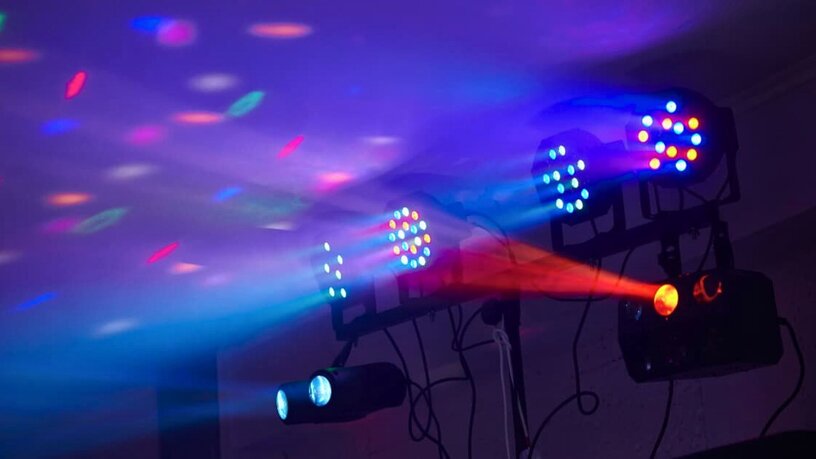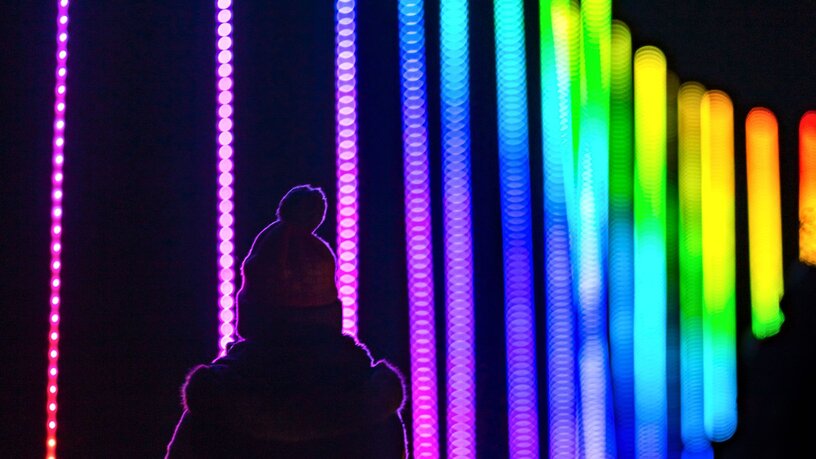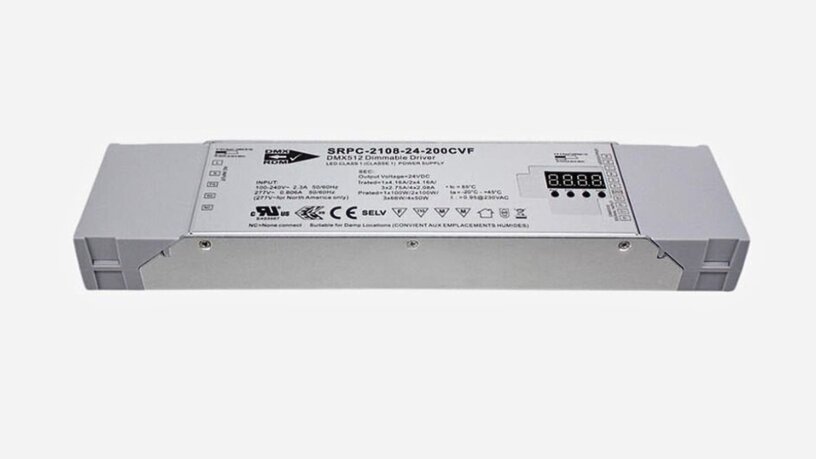Order by 23rd Dec 5pm for Pre-Xmas Delivery

What Is DMX Lighting?
Digital Multiplex (DMX) remains the industry workhorse for large-scale, synchronised lighting control - in entertainment venues and theatrical productions and across architectural, commercial, and retail spaces.
DMX ensures reliable control over multiple LED runs, luminaires, zones, and effects with flexibility for custom sequences and dynamic effects.
This guide explores LED DMX control in-depth, covering everything from DMX LED controller options to real-world applications and product specifications.
We’ll explore how to optimise DMX for various environments, discuss key considerations for product selection, and outline best practices.

What Is DMX?
At its core, DMX is a communication protocol that allows intricate control of LED and other lighting systems.
Lighting designers and technicians rely on this technology to manage complex, large-scale lighting setups - particularly in environments that require nuanced colour management and synchronised effects from a central control point, like theatre and concert venues, lighting for art gallery exhibitions, and event spaces.
The DMX512 protocol has become the industry standard, supporting data transmission for up to 512 channels within a single universe and offering exceptional flexibility for multi-zone installations of LED strips, controllers, and luminaires.

Presets
Presets are pre-saved colour states that can be instantaneously recalled, eliminating the need for manual colour mixing. They are stored on wall-mounted controllers, which allow users to save and recall custom colour settings, making it easy to trigger consistent lighting setups on demand.
Presets are ideal for commercial spaces that need to regularly switch between brand colours or venues that require fast, seamless transitions between moods, scenes or performances.

Sequences
Sequences introduce dynamic behaviour to static lighting systems by enabling programmed transitions between colours or scenes. Sequences can be looped or triggered via a controller to create complex visual effects - even in non-pixel RGB systems.
Lighting designers can use sequences to animate colour changes across zones, for example, gradually shifting from red to amber to yellow, or create more elaborate multi-step transitions that add depth and atmosphere to a space.
Modern DMX LED controllers often include drag-and-drop sequence editors that make building loops quick and intuitive.

Real-Time Effects
Real-time control showcases the full potential of DMX’s flexibility. This feature allows for instant signal adjustments, enabling lighting systems to adapt dynamically to external inputs.
Through sound-to-light software, sensor-triggered inputs or physical controllers, changing signals are sent to DMX decoders in real-time. This feature is crucial for live events, performances, and installations that demand immediate, reactive lighting changes based on audio, movement, or external triggers.

What Are DMX Decoders?
DMX decoders act as the critical interface between controllers and RGB/RGBW LED strip lights, translating DMX512 signals into PWM (Pulse Width Modulation) output - a signal the strips can understand and respond to. DMX decoders are most commonly used for colour-changing LED tape that isn't pixel or SPI-based.
It’s important to note that RGB/RGBW LED strips themselves aren’t intelligent; they’re simply dimmed by the decoder, which acts as the key link between the control system and the lighting output.
To get the most out of DMX lighting, it’s crucial to choose a DMX LED controller that aligns with the channel count and data rates needed by the decoder.
The LTECH 4 channel 5A RGBW DMX decoder is ideal for standard RGB/RGBW setups, while the LTECH 16 channel 3A decoder offers greater flexibility for larger installations.

Channels
In a DMX system, each lighting function, such as red, green, blue, white, or dimming, is allocated its own channel.
A basic RGB setup typically uses three channels, while more complex RGBW configurations may require four or more - depending on the system’s design.
Decoders with higher channel counts can support multiple LED strips at once; for instance, a 16-channel decoder can control four separate RGBW strips. A DMX channel guide provides a clear reference for mapping these functions to their respective channels, ensuring accurate and reliable control.

Addresses
DMX addressing is a crucial element of DMX system setup. Each decoder is assigned a unique start address depending on how many channels the decoder uses.
This granular control enables lighting designers to create complex, multi-zone installations using a single DMX line, preventing signal conflicts.
Two decoders set to the same address will produce identical outputs, which can be useful if you want multiple fixtures to behave the same way.
However, problems arise when addresses overlap unintentionally, potentially disrupting a carefully designed lighting scheme.

DMX Vs. SPI - Know The Difference
DMX and SPI are often mistaken for one another but are fundamentally different technologies. Understanding the difference is crucial as these systems are not interchangeable, and combining them can result in significant installation issues.
DMX is best suited for standard RGB and RGBW setups, using addressable decoders to control groups of lights. On the other hand, SPI is a signal format specifically for pixel-addressable strips, enabling pixel-level control.
SPI requires a compatible decoder (e.g., DMX to SPI) to operate pixel lighting, as DMX decoders cannot run pixel strips.

When DMX Is The Right Choice
A DMX lighting installation is especially well-suited for:
- Long-distance lighting runs where maintaining signal quality is essential
- Installations with multiple independently controlled zones
- Installations requiring precise control
- Staging for live events or festivals that need real-time lighting changes with high precision
- Spaces where wireless control is impractical or unreliable, such as larger events or commercial spaces

FAQs
Can I use DMX with pixel strips?
Standard DMX decoders are not compatible with the SPI signal used by pixel strips. However, specialised SPI-to-DMX decoders are available. These convert DMX signals for use with pixel LED systems.
Can I use the same address across multiple decoders?
Only if you want all decoders to produce the same output. For independent control, each decoder must be assigned a unique DMX address.
How many channels can DMX512 handle?
DMX512 provides up to 512 control channels per universe. RGB products use 3 channels each, so careful planning is essential when using large numbers of fixtures.
What’s the difference between SPI and DMX?
DMX sends control data to a decoder, which controls groups of LEDs. SPI sends data directly to each pixel for individual control. The two systems are not compatible.
Why choose DMX over RF or Bluetooth?
Wireless options like RF and Bluetooth work well for smaller setups. DMX is better suited to larger, multi-zone installations that require stability, long cable runs, or synchronised control. It is more scalable and reliable for demanding environments.
DMX control is ideal for installers managing RGB and RGBW systems across complex setups. Ultra LEDs offers a full range of DMX-compatible products, backed by technical guidance to support custom lighting projects.
For expert advice or help selecting the right products, speak to our technical team or explore the full DMX-compatible range online.
Author: Jack Bennett, Technical Engineer @ Ultra LEDs
Get in touch with UltraLEDs today
If you're working on a lighting install for live events, theatre, or performance spaces, Ultra LEDs supplies DMX-compatible LED strips, drivers, and control systems. Built for stable output, smooth dimming, and multi-zone control across complex setups.





